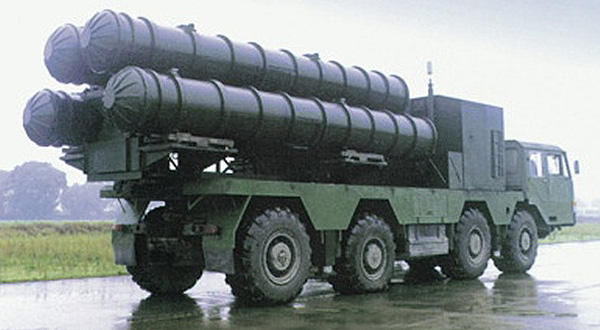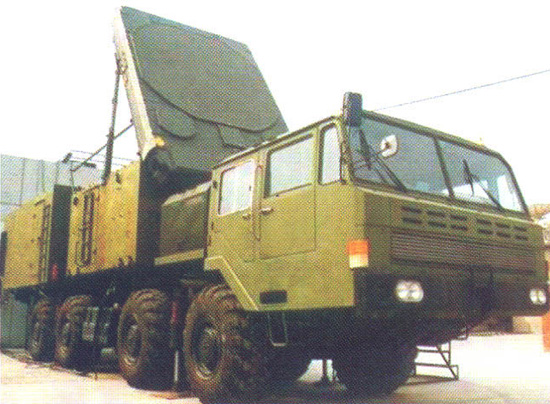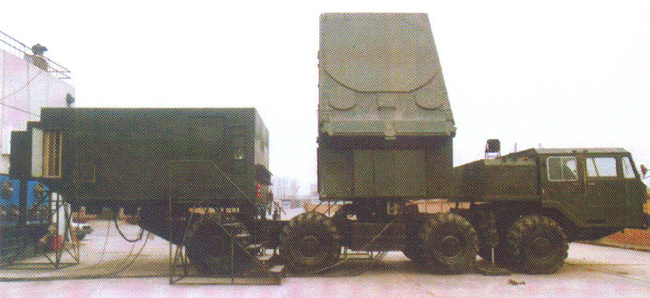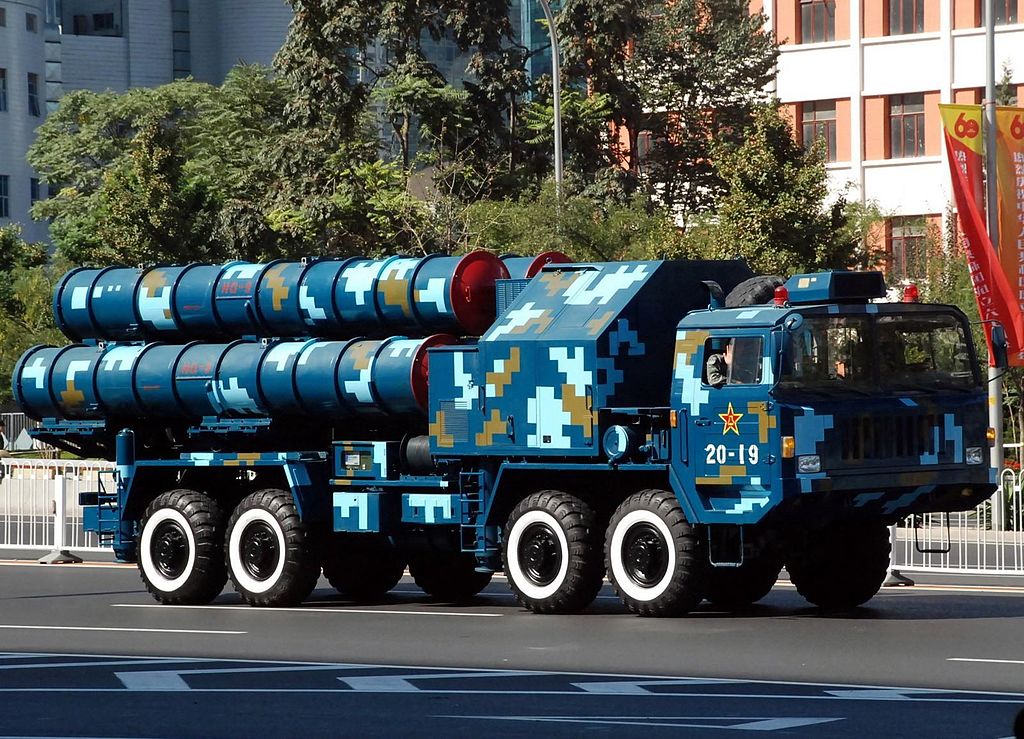| HQ-9 (FT-2000) SURFACE-TO-AIR MISSILE SYSTEM
中国红旗(HQ)-9型(FT-2000)地对空导弹系统 Date:2016-08-14 Source:Sinodefenceforum By:Globalmil Viewed: |

The only available photo of the FT-2000 reveals certain features of the HQ-9 missile system. Like the Russian S-300PMU, the FT-2000 is cold-launched vertically from an indigenous Taian TA5380 8X8 heavy-duty transport-erector-launcher (TEL) vehicle.
FT-2000的唯一可得的图片展示某些HQ-9导弹系统的特征。类似俄国S-300 PMU,FT-2000采用“冷-发射”垂直从一辆Taian TA5380 8X8重载运输-架设-发射装置(TEL)车辆上发射。
The HongQi-9 (HQ-9) is a long-range, all-altitude, all-weather surface-to-air missile system to counter aircraft, helicopters, and cruise missiles. It also has limited capabilities against tactical ballistic missiles. Developed by China Academy of Defence Technology, the missile system may have entered service with the PLAAF Surface-to-Air Missile Corps in limited numbers since 1997. A shipborne version is being deployed onboard the PLA Navy’s Type 052C air defence missile destroyer. An anti-radiation variant known as FT-2000 has also been promoted to the export market.
“红旗”(HongQi)-9(HQ-9)是远程、全-高度、全天候地对空导弹系统,去对抗飞机、直升飞机和巡航导弹。它也已经具有有限的对抗战术弹道导弹能力。由中国防卫技术研究院发展,有限数量的导弹系统可能从1997年以后已经进入PLAAF地对空导弹团服役。一种舰载型被配置到PLA海军的052C型防空导弹驱逐舰上。一种反辐射改型即是FT-2000,也已经被推销到出口市场。
PROGRAMME
计划
计划
The HQ-9 was developed by China Academy of Defence Technology (CADT), China’s leading surface-to-air missile designer and manufacturer located in the western suburb of Beijing. A subordinate of China Aerospace Science & Industry Corporation (CASIC), the academy is also known as China Changfeng Mechanics and Electronics Technology Academy, or 2nd Aerospace Academy. An export variant FT-2000 fitted with an anti-radiation seeker has been promoted by China National Precision Machinery Import and Export Corporation (CPMIEC) to the international market.
HQ-9由中国防卫技术研究院(CADT)发展,中国主要的地对空导弹设计和和制造部门,位于北京西郊。中国航天科工集团公司(CASIC)的一个下属部门,研究院也是即是中国Changfeng力学和电子学技术研究院,或第二航空宇宙研究院。FT-2000装有一种反辐射自导引弹头,已经被中国国家精密机械进和出口公司(CPMIEC) 推销到国际市场。
The HQ-9 development programme began in the early 1980s. The missile design was initially based on some limited U.S. Patriot air defence missile technology, but was later incorporated with Russian S-300 missile design and technologies. Like the Patriot, the HQ-9 uses a ‘Track-Via-Missile’ (TVM) terminal guidance system. The early prototype was launched from a Patriot-style slant-positioned box-shape container launcher, but the missile was seriously oversize due to China’s substandard solid fuel rocket technology. After China imported the S-300PMU missile from Russia in the early 1990s, the HQ-9 missile was redesigned to incorporate Russian missile rocket, aerodynamic layout, and launch system. The resulting HQ-9A is ‘cold-launched’ vertically from a S-300-style tube launcher system.
HQ-9发展计划在1980年早期开始。导弹设计最初以一些有限的美国“爱国者”防空导弹技术为基础,但是稍后吸收了俄国S-300导弹设计和技术。类似“爱国者”,HQ-9使用一种“跟踪-经由-导弹”(TVM)末段制导系统。早期原型从一个“爱国者”-风格的倾斜放置箱体形发射装置发射,但是导弹确实是特大号的归于中国非标准的固体燃料火箭技术。在1990年早期中国引进了俄国的S-300 PMU导弹以后,HQ-9导弹被重新设计综合俄国导弹火箭、空气动力学布局和发射系统。研制出的HQ-9A采用“冷-发射”技术,垂直地从一种S-300风格的管形发射系统中发射。
The HQ-9 was initially developed to replace the PLA’s bulk of obsolete HQ-2 (Chinese copy of the Soviet/Russian SA-2 Guideline), but the slow progress in the development forced the PLA to purchase the S-300PMU missile from Russia. By the time the HQ-9 was ready for operational deployment in the late 1990s, the missile was already behind foreign air-defence missiles such as U.S. PAC3 and Russian S-300PMU2 in terms of technology and performance. Only a small number of the HQ-9A are being deployed by the PLA for operational trial and evaluations. The naval variant of the HQ-9A is deployed onboard the Type 052C destroyer which was commissioned in 2004.
HQ-9最初发展去代替PLA大量陈旧的HQ-2(苏联/俄国SA-2“方针”(Guideline)的中国仿造型),但是发展的慢速进展迫使PLA从俄国购买S-300 PMU导弹。在时间上HQ-9在1990年后期准备用于操作部署,导弹在技术和性能条件上已经落后于一些先进的国外防空导弹,像是美国PAC3和俄国S-300 PMU2。只有少量的HQ-9A用于操作试验和评估被PLA部署。HQ-9A的海军舰载改型在2004 年服役的052C型驱逐舰上配置。
MISSILE
导弹
导弹
The HQ-9 is reported to have a slant range of 200km up to an altitude of 30km. The missile has a proximity fuse with an effective range of 35m, which goes active when the missile is 5km away from its target. The missile is transported and launched on Taian TAS5380 8X8 transport-erector-launcher (TEL), which has four canisters that look almost identical to those used in the S-300PMU1. Like the S-300, the FT-2000 is cold-launched.
HQ-9据说倾斜射程200公里,高度直到30公里。导弹的近炸引信有效范围35米,当导弹距离目标5公里远时开始起作用。导弹在一辆Taian TAS5380 8X8运输-架设-发射装置(TEL)车上被运输和发射,四个几乎看起来与S-300 PMU1所使用相同的发射箱。类似S-300,FT-2000采用“冷-发射”。
GUIDANCE & FIRE CONTROL
制导&火控
制导&火控


The HQ-9 system uses a large HT-233 3D phased array radar (PAR) for surveillance and target acquisition. The radar is also used on the KS-1A intermediate-range SAM. The radar is said to be capable of tracking 50 targets simultaneously. The HQ-9 may also be compatible with the Russian tracking radar, making it suitable to be deployed in combination with the S-300. (Photo: via China-Defense.com forum)
HQ-9系统使用一个大型的HT-233 3D相控阵雷达(PAR)用于监视和目标探测。雷达在KS-1A中-程防空导弹(SAM)上也被使用。雷达据说能够同时地追踪50个目标。HQ-9也可能与俄国兼容追踪雷达,致使适用于和S-300联合部署。
The HQ-9’s guidance is very similar to that of the Patriot missile, consisting of inertial initial guidance + radio command midcourse correction + track-via-missile (TVM) terminal guidance. Midcourse correction commands are transmitted to the guidance system from the ground engagement control station. The target acquisition system in the missile acquires the target in the terminal phase of flight and transmits the data using the TVM downlink via the ground radar to the engagement control station for final course correction calculations. The course correction commands are transmitted back to the missile via the command uplink.
HQ-9制导非常相似“爱国者”导弹,包括惯性最初引导+无线电指令中段修正+跟踪-经由-导弹(TVM)末段制导所组成。中段修正指令从地面交战控制战传送到引导系统。导弹的目标探测系统在飞行末段获得目标和传输数据使用TVM下行链路,由地面雷达到交战控制站用于最后方向修正量计算。方向修正指令经由指令上行链路传输返回到导弹。
The HQ-9 system reportedly uses a large HT-233 3D C-band mono-pulse planar phased array radar, which operates in the 300MHz bandwidth and has a detection range of 120km and tracking range of 90km. The radar can detect targets in azimuth (360 degrees) and elevation (0 to 65 degrees), and is capable of tracking some 100 airborne targets and simultaneously engaging more than 50 targets. The radar system is carried on a Taian TAS5380 8X8 heavy-duty cross-country vehicle.
HQ-9系统据传使用一个大型HT-233 3D C-波段单脉冲平面相控阵雷达,在300 MHz带宽中操作,探测距离120公里和追踪距离90公里。雷达能发现方位(360度)和俯仰角(0到65度)的目标,而且能够追踪大约100个空中目标和同时交战超过50个目标。雷达系统携带在一辆Taian TAS5380 8X8重载越野车辆上。
HQ-9系统据传使用一个大型HT-233 3D C-波段单脉冲平面相控阵雷达,在300 MHz带宽中操作,探测距离120公里和追踪距离90公里。雷达能发现方位(360度)和俯仰角(0到65度)的目标,而且能够追踪大约100个空中目标和同时交战超过50个目标。雷达系统携带在一辆Taian TAS5380 8X8重载越野车辆上。
The HQ-9 may also be compatible with the Russian tracking radar, making it suitable to be deployed in combination with the S-300.
HQ-9也可能与俄国的跟踪雷达兼容,致使它适于与S-300联合部署中。
FT-2000
FT-2000
FT-2000
In 1998 CPMIEC revealed a unique anti-radiation surface-to-air missile system FT-2000, which was designed engage airborne warning and control system (AWACS) and other electronic warfare aircraft at long ranges. Based on the HQ-9 design, the FT-2000 is fitted with a passive radar-homing seeker and is launched from a 8X8 transport-erector-launcher (TEL) vehicle carrying four missile tube launchers.
在1998年CPMIEC展示了独特的FT-2000反辐射地对空导弹系统,设计在远距离同空中指挥管制机(AWACS)和其它的电子战飞机交战。基于HQ-9设计,FT-2000安装一套被动-导引搜索头,装载在一辆8X8运输-架设-发射装置(TEL)车上,携带四个导弹管形发射装置。
在1998年CPMIEC展示了独特的FT-2000反辐射地对空导弹系统,设计在远距离同空中指挥管制机(AWACS)和其它的电子战飞机交战。基于HQ-9设计,FT-2000安装一套被动-导引搜索头,装载在一辆8X8运输-架设-发射装置(TEL)车上,携带四个导弹管形发射装置。
The FT-2000 is a scaled down version of the HQ-9 fitted with a passive radar seeker that homes the missile using the electronic emission of enemy AWACS and electronic warfare (EW) aircraft. When the missile detects and locks on to the radar or jammer, it can home on the target autonomously at 1,200m/s while sustaining a 14G overload. The FT-2000 can also be used in co-operation with friendly aircraft when the onboard radar warning receiver detects hostile signal. In addition, the FT-2000 missile has a built-in inertial navigation system, so that whenever it has acquired a lock-on, it will continue towards the target even if the emitter is shut down, although the missile's accuracy would seriously degrade in this case.
FT-2000是一种HQ-9缩小型,配备有一套无源导引头,导弹导引使用敌人的空中指挥管制机和电子战(EW)飞机的电子辐射。当导弹探测和锁定到雷达或干扰机上的时候,它能维持14G过载在1,200米/秒的速度自动在信号引导下到达追踪目标。当弹载雷达告警接收机发现敌方信号时候,FT-2000也能和友好飞机联合操作下使用。除此之外,FT-2000导弹有一个内建的惯性导航系统,所以只要已经获得一个锁定,它将会向目标持续朝向目标,即使发射源关闭,尽管导弹的精度会在这种情况严重地降低。
For the detection and localisation of hostile radar emissions and jammers the FT-2000 makes use of four ground-based Electronic Support Measures (ESM) sensor posts, each of which is mounted on wheeled vehicles and can together track 50 targets simultaneously. The ESM sensor posts are deployed at a distance 30km from each other. The missile launchers are deployed near the central ESM sensor station at a distance of 150 metres. Additionally, the missile can also be used in conjunction with surveillance and target acquisition radars.
用于敌方雷达发射和干扰机探测和锁定位置,FT-2000利用四个地-基电子支援措施(ESM)传感器站,每个被安装在轮式车辆上和能同时共同追踪50个目标。电子支援传感器站在彼此距离30公里展开。导弹发射装置接近电子支援传感器站的中心在150米距离部署。额外地,导弹也能联合探测和目标搜索雷达使用。
用于敌方雷达发射和干扰机探测和锁定位置,FT-2000利用四个地-基电子支援措施(ESM)传感器站,每个被安装在轮式车辆上和能同时共同追踪50个目标。电子支援传感器站在彼此距离30公里展开。导弹发射装置接近电子支援传感器站的中心在150米距离部署。额外地,导弹也能联合探测和目标搜索雷达使用。
Despite being regarded as the first of its kind in the world, the real effectiveness of the FT-2000 in operation was somehow doubtful. The missile caught great attention when it was first revealed in 1998, but did not enter production due to lack of interest from either domestic or international market.
尽管被视为世界上第一种此类型,FT-2000在操作上的 真正效能不知何故是有疑问的。当它在1998年被首次展示的时候导弹引起广泛关注,但是没有进入生产,由于国外或国际市场缺乏兴趣。
补充资料(来自wikipedia网站):
HQ-9
Radars
雷达
To reduce the cost, the HQ-9 is designed to be flexible enough to employ a wide range of radars, both the search/surveillance/acquisition radar and the tracking/engagement/fire control radar (FCR).
为了降低成本,HQ-9可以灵活的采用范围广泛的雷达,无论是搜索/监视/搜索雷达和跟踪/交战/火控雷达(FCR)。
Fire control radar
火控雷达
火控雷达
Many FCRs of other Chinese SAM can be used for HQ-9, such as FCR used in KS-1 SAM, SJ-212, itself an enlarged and improved version of the SJ-202 fire control radar (FCR) used in HQ-2J.[6][10] H-200 & SJ-231 FCRs of latter models of KS-1 SAM are also compatible with HQ-9.
许多其他中国地对空导弹(SAM)的火控雷达(FCR)可用于HQ-9型,如使用在KS-1型地对空导弹(SAM)的火控雷达,SJ-212型,它本身是HQ-2J型使用的SJ-202型火控雷达(FCR)的扩展和改进型号。后期型号H-200&SJ-231型火控雷达用于KS-1型防空导弹同时也兼容HQ-9型。
HT-233 Radar
HT-233雷达
To maximize the combat effectiveness of HQ-9, a dedicated FCR for HQ-9 was developed, and it is most commonly seen with HQ-9. Designated as HT-233, this radar is the most advanced FCRs HQ-9 could employ, and it has greater similarities to the MIM-104 Patriot's MPQ-53 than the S-300's 30N6 (Flap-Lid) series,working in the NATO G-band (4–6 GHz) also as a search and targeting radar. This could be due to an alleged transfer of a Patriot missile to China from Israel.The radar can search a 120 degree arc in azimuth and 0-90 degrees in elevation out to 300 km, with a peak power output on 1MW (average 60 kW). The radar is credited as being able to track 100 targets and guides up to 6 missiles to 6 targets, or alternatively, to 3 targets with a pair of missile for each target.
为了最大限度地提高HQ-9作战能力,为HQ-9开发了一种专用火控雷达(FCR),它是同HQ-9型最常见一起看到的。被指定为HT-233型,这种雷达是目前HQ-9型可以采用最先进的火控雷达 ,而且它和MIM-104爱国者的MPQ-53型有更大的相似之处超过S-300的30N6型(“活动盖”,Flap-Lid)系列,工作在北约G波段(4-6千兆赫)也可作为一部搜索和定位雷达。这可能是由于从以色列到中国爱国者导弹的一个涉嫌转移。该雷达可搜索方位角120度和仰角0-90度,在射角范围达到300公里,峰值功率输出在1MW(平均为60千瓦)。该雷达被认为能够跟踪100个目标,并引导多达6枚导弹打击6个目标,或者,对3个目标用双发导弹作战方式打击每一个目标。
HT-233 is the FCR used by HQ-9 that is closest to AN/MPQ-53: In comparison to earlier H-200 radar used by early models of KS-1 SAM which uses a simple horn instead of lens arrangement, HT-233 radar adopts lens arrangement of AN/MPQ-53. In comparison to SJ-231 radar used by the latest model of KS-1, HT-233 has a thousand more phase shifter on its antenna array, totaling four thousand, as opposed to the three thousand of SJ-231. In contrast, both AN/MPQ-53 & 30N6E radars have ten thousand phase shifters on their antenna arrays respectively. HT-233 radar is mounted on Tai'an TAS5501 10 x 10 high mobility cross country truck, and operates in C-band at 300 MHz. When deployed as a search radar TH-233 is fielded at brigade level, while FCR radars deployed would be SJ-212, H-200 or SJ-231.[3] HT-233 is credited with a detection range of 120 km,scanning 360 degrees in azimuth and 0-65 degrees in elevation. It can track 100 targets and designate 50 for engagements.
HQ-9使用的HT-233型火控雷达最接近AN/MPQ-53型:在比较由KS-1型地对空导弹的早期型号使用较早的H-200型雷达,它使用了一个简单喇叭状装置代替透镜装置,HT-233型雷达,采用AN/MPQ-53的透镜布局。在KS-1中使用最新型号SJ-231雷达相比,HT-233型它的天线阵列上多一千多个移相器,共计四千个,而不是SJ-231型三千个。与此相反,AN/MPQ-53和30N6E雷达分别在其天线阵列有10000个移相器。HT-233型雷达安装在泰安TAS550110×10型高机动性越野车上,并在C波段300 MHz运行。当部署TH-233搜索雷达,在旅一级调遣,而火控雷达部署将是SJ-212型,H-200型或SJ-231型。HT-233型具有120公里的探测距离,扫描方位角度360度,俯仰角0-65度。它可以跟踪100个目标,并指定50个用于交战。
Search radars
Several search radars are discovered to be associated with HQ-9, including anti-ballistic radars and anti-stealth radars.
Type 305B radar
Type 305B radar
Type 305B (also known as LLQ-305B) radar is the standard search radar for HQ-9, and it is a development of YLC-2 Radar. This 3-D radar which has an antenna height of 3.5 meters, and employs sixty 350 mm waveguide feeds. It operates in the S-band at a wavelength of 11.67 cm.
Type 120 radar
Type 120 (also known as LLQ-120) radar is the low altitude search radar, it is a telescoping radar with an antenna height of 2.3 metres folded, and 7 metres unfolded, using a feed network of sixteen 230mm wave guides. It rotates at a maximum of ten revolutions per minute, and operates in the L-band at a wavelength of 23.75 cm.
Type 305A radar
Type 305A (also known as LLQ-305A) radar is another search radar for HQ-9 system. This AESA radar is designed maximize the anti-ballistic capability of HQ-9, and it resembles Thales Ground Master 400 AESA radar. Very little info is released about this radar other than it can also act as Fire-control radar.
YLC-20 passive sensor
Although Type 305 radars are effective against stealthy targets such as F-35, full stealth target such as B-2 is difficult to detect. YLC-20 passive radar was conceptually based on KRTP-91 Tamara passive sensor, incorporating experience obtained from documentation acquired during the abortive attempt to procure six Czech VERA passive sensors. YLC-20 passive radar was first revealed in 2006.
DWL002 passive sensor
DWL002 passive radar is the development of earlier YLC-20, incorporating Kolchuga passive sensor, four of which were sold to China.Like its predecessor YLC-20, DWL002 is also developed by China Electronics Technology Corp. (CETC).
搜索雷达
一些搜索雷达被发现与HQ-9型有关,包括反弹道导弹雷达和反隐身雷达。
305B型雷达
305B型(也称为LLQ-305B型)雷达用于HQ-9型标准的搜索雷达,它是YLC -2型雷达的一个发展。这种3-D雷达天线高度3.5米,并采用60个350毫米波导反馈管。它在工作在S波段波长11.67厘米。
120型雷达
120型(也称为LLQ-120型)雷达是低空搜索雷达,它有一个可伸缩雷达天线折叠2.3米高,展开7米高,使用十六个230毫米波导反馈管组网。它以最大每分钟十转旋转,并在L波段23.75厘米波长操作。
305A型雷达
305A型(也称为LLQ-305A型)雷达是HQ-9系统,另一种搜索雷达。这种AESA雷达的目的是最大限度地提高HQ-9反导能力,它类似于泰利斯公司Ground Master 400 AESA雷达。针对此雷达以外很少的信息被发布,还可以作为火控雷达。
YLC-20型无源传感器
虽然305型雷达是反隐身目标,如F-35是有效的,全隐身目标如B-2则难以检测。YLC-20型无源雷达的构思基于KRTP-91型塔玛拉无源传感器,结合未成功的试图购买6套捷克VERA无源传感器期间取得的文件获得的经验。YLC-20型无源雷达于2006年首次发现。
DWL002型被动传感器
DWL002型被动雷达从早期YLC-20型发展,包括铠甲(Kolchuga)无源传感器,其中四套卖给了中国。像其前身YLC-20型,DWL002也由中国电子科技集团(CETC)开发。
Variants
改型
改型
FD-2000 - First revealed in the 8th Zhuhai Airshow, the export version of HQ-9, providing extra anti-stealth capability by incorporating YLC-20 passive radar sensor as an option.FD-2000 made its name by once securing Turkish surface-to-air missile contract, later cancelled due to political reasons. FD2000's reaction time from radar contact to missile engagement is around 12–15 seconds. It covers an area of 49000 square kilometres. FD-2000 was on exhibition in Zhuhai Airshow 2014.
FT-2000 - Anti radiation version that was the first model of HQ-9 family being completed.
HQ-9 - TVM version SAM.
HHQ-9 — Naval version.
HQ-9A — Upgraded version, first tested in 1999 and service entry in 2001.Chinese sources claim that the HQ-9 family of systems employ much newer computing technology than imported Russian S-300PMU/PMU1/PMU2 systems, because HQ-9 is developed more than a decade later, thus allowing it to incorporate advancement in microelectronics. Due to the superior computing capability for signal processing, data processing and guidance support, this missile can have an optional semi-active radar homing (SARH) mode, because more info can be processed on board the missile itself.
HHQ-9A — Ship-borne naval version of HQ-9A. Eight 6-cell vertical launch silos, of cylindrical shape and using "cold launch" method, mounted on the Type 052C destroyer (48 missiles in total).
HQ-9B — reportedly tested in February 2006.According to Jane's Information Group, this missile has a dual seeker that incorporates both SARH & infrared homing mode
HQ-9C - Currently under development, incorporating active radar homing mode.
HQ-19 - A vastly upgraded version of HQ-9 to counter ballistic missile and satellites on the lower end of Low Earth orbits, and it is the Chinese equivalent of THAAD.[21] HQ-19 is armed with a dual purpose exosphere kinetic kill vehicle (kkv) warhead designed by a team led by Professor Zhou Jun (周军), which can be used against ballistic missile warheads or satellites.Its first flight occurred in 2003; since then, the missile has conducted several other tests, including one on November 1, 2015.
SC-19 - HQ-19 derivative using Kaituozhe-1 space booster as engine instead of the original engine used in HQ-9/19. Due to the size difference of engines, SC-19 also has to adopt a new launcher/transporter designated as KT-409.Like HQ-19, SC-19 can also be used to counter either ballistic missile or satellite on the lower end of low Earth orbits.
HQ-26 - Chinese equivalent of SM-3 for naval deployment,upgraded HQ-9/19 equipped with a dual pulse solid rocket motor for the final stage like SM-3.Its certification is expected in 2015 at the earliest.
HQ-29 - Chinese equivalent of MIM-104F (PAC-3) (PAC-3), with engine upgrade for the final stage: instead of a single dual pulse solid rocket motor, HQ-29 is equipped with over a hundred tiny pulse solid rocket motors mounted in the forebody of the missile,but the exact number remain unknown due to lack of publicized information. Its first flight was achieved in 2011 and it is expected to be deployed by the end of the Twelfth Five-Year Plan.At least one additional test was conducted in 2013.
FD-2000型 - 首次展示,在第8届珠海航展上,HQ-9的出口型,通过结合YLC-20无源雷达传感器作为选装配置提供额外的反隐身能力。FD-2000型是一次同土耳其地对空导弹合同中用的名称,后来该合同取消了,由于政治上的原因。FD2000的反应时间从雷达与导弹投入约12–15秒。占地面积49000平方公里。 2014年FD-2000型在珠海航展。
FT-2000型 - 反辐射型号,这是HQ-9系列完成的第一款改型。
HQ-9型- 导弹跟踪(TVM)制导的地对空导弹。
HHQ-9 - 海军型号。
HQ-9A - 升级型号,在1999年首次测试和2001年进入服役,消息来源称HQ-9系统系列相比俄罗斯进口S-300PMU/PMU1/PMU2系统采用非常新的计算机技术,因为十多年过去后发展HQ -9,从而使其能够结合进步的微电子技术。由于超强的计算机能力用于信号处理,数据处理和引导支持,这种导弹可以有一个可选的半主动雷达制导(SARH)模式,因为更多的信息可以在导弹本身弹载系统上进行处理。
HHQ-9A - HQ-9A舰载海军型号。八组6单元垂直发射单元,圆柱形,用“冷发射”方式,安装在052C型驱逐舰上(总共48枚导弹)。
HQ-9B - 报道在2006年2月测试,根据简氏信息集团的消息来源,这种导弹具有双重导引头包含半主动辐射寻的(SARH)与红外寻的模式。
HQ-9C - 目前正在开发中,结合主动雷达制导模式。
HQ-19 - HQ-9的重大升级型号以对抗弹道导弹和在低地球轨道低端的人造卫星,它相当于中国的THAAD。红旗-19导弹装备有双重目的外大气层动能拦截器(KKV)战斗部,由Zhou Jun (周军)教授领导的一个团队设计,可以针对弹道导弹弹头或卫星。.它首次飞行发生在2003年;自那时以来,该导弹已进行其他几项测试,其中包括2015年11月1日的一次。
SC-19 - HQ-19衍生型采用开拓者-1助推器而不是用于红旗9/19原发动机。由于发动机的大小不同,SC-19也有采用新的发射装置/运输载具并指定为KT-409型。像HQ-19,SC-19也可使用去对抗任何导弹或低地球轨道下端上的卫星。
HQ-26 - 相当于中国的SM-3导弹在中国海军部署,升级版的HQ-9/19搭载了双脉冲固体火箭发动机用于末级像SM-3一样。最早有望在2015年部署。
HQ-29 - 相当于中国的MIM-104F(PAC-3),发动机为末级升级:而不是一台单一的双脉冲固体火箭发动机,HQ-29百余台微小的脉冲固体火箭发动机安装在导弹的弹体前部,但确切的数字,由于缺乏公开的信息仍未知。它的首次飞行在2011年实现,有望在第十二个五计划结束时部署。.至少在2013年实施了一次额外的测试。
上一篇:没有了 下一篇:HQ-7 (FM-80) SURFACE-TO-AIR MISSILE SYSTEM
| HQ-3(Hongqi-3)Air defense missile
中国“红旗”(HQ-3,Hongqi)-3号防空导弹 |
| Hongqi-3 missile weapon system had incorporated a lot of newly developed items. 28 organizations which participated the work were from the 1st, 3rd, 4th, 5th and 7th Ministries of Machine Building and Air Force. Actually the country wide coo... [2020-04-06] |
| KS-1 SURFACE-TO-AIR MISSILE SYSTEM
中国“凯山”(KaiShan)-1(KS-1)地对空导弹系统 |
| The KaiShan-1 (KS-1) is a medium- to long-range, all-altitude surface-to-air missile system developed by China Academy of Defence Technology (CADT).... [2017-01-07] |
| HQ-7 (FM-80) SURFACE-TO-AIR MISSILE SYSTEM
中国HQ-7(FM-80)防空导弹系统 |
| The HQ-7 (also known as FM-80 in its export form) is an all-weather short range air defence system developed by 2nd Aerospace Academy (now China Academy of Defence Technology) on the basis of the French Crotale air defence missile. ... [2017-01-07] |
| HQ-9 (FT-2000) SURFACE-TO-AIR MISSILE SYSTEM
中国红旗(HQ)-9型(FT-2000)地对空导弹系统 |
| The HongQi-9 (HQ-9) is a long-range, all-altitude, all-weather surface-to-air missile system to counter aircraft, helicopters, and cruise missiles. It also has limited capabilities against tactical ballistic missiles.... [2016-08-14] |


